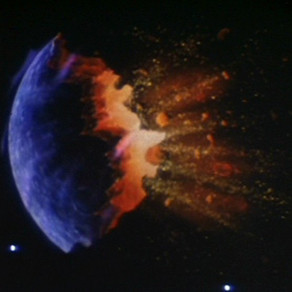Klingon Task Force Main Page
|
|

|
|
|
PRAXIS MYSTERY
by Dewald de Coning

In 2293 a combination of overmining
and insufficient safety
precautions led to the Klingon moon Praxis – the Klingon
empire's key energy production facility – exploding in a violent
cataclysm that had numerous far-reaching
consequences.
The Klingon moon exploding caused significant disruption in
the atmosphere of Qo'nos by destroying most of its ozone layer,
leaving the planet with approximately fifty standard Earth years
of oxygen. It emitted a subspace shock wave traveling in excess
of the speed of light, deduced from the fact that a Federation star
ship on the other side of the Neutral Zone, the USS Excelsior,
was buffeted by the subspace shock wave from the exploding
moon within a matter of minutes.
This incident has been seen by many as evidence of the
incredibly advanced level of Klingon power generation technology. With regard to this event in
Klingon history, some interesting questions have subsisted over the years. Even more interesting
explanations have been given to some of those questions. But in order for us to investigate the
validity of those explanations, we must first understand the concept of “subspace”.
What is “subspace”?
Subspace is one of several “layers” of the spacetime
continuum, and exists colinearly
with real
space and hyperspace.
Objects in subspace can interact with objects in real space. A longrange
subspace sensor return
signal would be useless if it did not reflect off objects in real space.
All points in subspace coincide with points in real space. That is why subspace sensors can
determine both distance and direction.
There is a weak interaction between subspace and real space.
Objects in subspace can apparently travel at virtually any desired speed.
Objects can exist partially in subspace. Most of the mass of a star ship is “submerged” in subspace
when it activates its socalled
“mass-lightening
field”.
Subspace contains very little matter or energy.
Objects in subspace will not naturally stay there out of their own accord. A natural attraction draws
mass or energy from subspace into real space, unless it's actively being kept in subspace by some
technological means.
Subspace responds very strongly to mental manipulation.
There appears to be little or no inertial resistance to acceleration in subspace. Star ships apparently
do not have to expend any energy to accelerate the portion of their mass that is submerged into
subspace.
Some interesting questions raised
• How could a shock wave move at speeds in excess of the speed of light? We know from our
current understanding of nuclear physics that even an infinite amount of energy will not
accelerate subatomic
particles beyond the speed of light.
◦ We are entering the realm of conjecture here, but it would seem that most of the energy
of the Praxis blast may have been pushed into subspace. Since Praxis was an energy
production facility, it's entirely possible that it might have been employing technology
that could have caused this to happen.
• What did this shock wave consist of? A shock wave is a pressure wave that moves through
matter (for example earthquakes). In the vacuum of space a shock wave can only exist as a
moving “front” to matter. But where would all this matter come from, in order to produce a
shock wave that is still visibly dense after dispersing over a distance of many light years?
The mass of Praxis would have been insignificant at this distance.

◦ The “simple” answer to this question is that this
shock wave could not conceivably have contained
any solid matter. A moon (or even a planet, or a
star) simply does not contain enough mass to
produce a consequential shock wave many light
years away. If we assume that the mass of Praxis was entirely converted to electromagnetic
radiation and hurled into subspace, the USS Excelsior would have been
buffeted by less than 10 Gigajoules
of energy at that distance. Since this is nowhere near
its shielding limits, it would explain why it wasn't damaged. But, that said, why then was
the Excelsior still knocked off-course
by the impact of the blast? As the ship was
traveling at high-impulse
power at the time, most of its mass would have been submerged
into subspace. We now know that there is absolutely no inertial resistance to acceleration
in subspace. Consequently, we can assume that the only resistance to acceleration would
have been the portion of the mass of the Excelsior that was still in real space. That
portion of its mass would have acted as an “anchor”, to slow down the subspace-submerged
portion of the ship that would otherwise have been dragged along with the
energy of the shock wave. Since almost all of the mass of a Federation starship is in
subspace during high-impulse
(up to as much as 99.999999%), this explains the large
recoil experienced by the Excelsior, in spite of the small increase in momentum that
should have resulted from the blast. Interestingly enough, the Excelsior might have been
virtually unaffected by the blast, had it been coasting in stead of running at high impulse.
• Why didn't the blast destroy Qo'nos?

◦ Precisely because the mass/energy of the moon was submerged into subspace, it passed
through Qo'nos with minimal interaction. Electromagnetic
interaction between the blast
wave and the ozone molecules in the atmosphere of Qo'nos resulted in the disruption of
molecular bonds in those very ozone molecules, which led to the loss of the ozone layer
itself. This also explains why space stations in the vicinity of Qo'nos were not destroyed.
As they are stationary, their mass would have been entirely in real space (just like the
mass of Qo'nos itself) and they would have sustained only slight damage as a result of
their weak interaction with the subspace energy of the shock wave. All of the denizens
and structures on Qo'nos would have suffered mild cellular and molecular damage, since
the blast wave would have passed through the entire planet with the same weak
interaction that had caused the destruction of the ozone layer. The Klingon High
Command may have conceivably concealed this information from its populace and
outsiders to keep the true extent of the disaster from becoming public knowledge.
• How could we see the shock wave moving towards us? After all, it was moving in excess of
the speed of light, so we should not have been able to see anything until the moment the
shock wave had reached us, as it would quite literally have been outracing
its own image.
◦ The scene must have been depicted from the perspective of a starship or space station
near Qo'nos. View screens on star ships and space stations are programmed to create
visible representations of objects that are not normally visible.
• Why was the shock wave a planar ring?

◦ Simply put, the shock wave could not
have been a planar ring. It must have
been a spherically-expanding
phenomenon. The planar shape of the
blast wave had to be part of the visual
algorithms of view screens on nearby star
ships and space stations. These
algorithms are designed to depict space phenomena in such a manner that the crew can
see the phenomena and react to it, without having the entire view screen obscured. If the
shock wave had to be depicted in its true, spherical shape, then nothing behind the wave
front would have been visible to the crews on nearby star ships and space stations.
|

